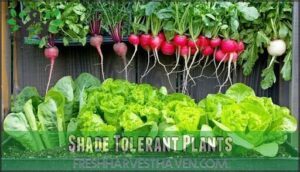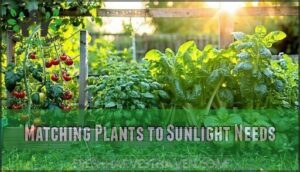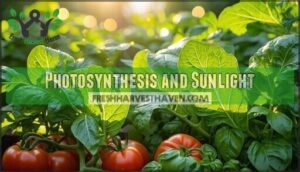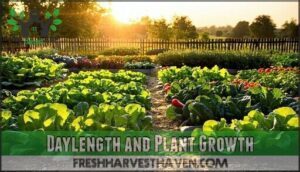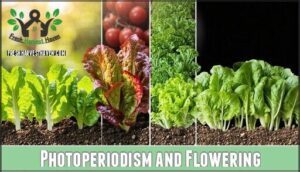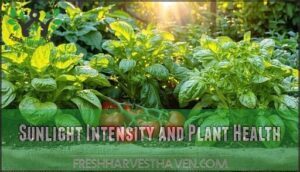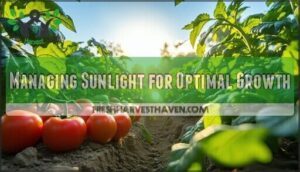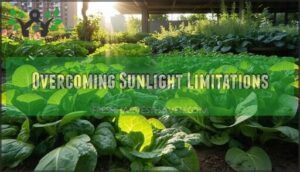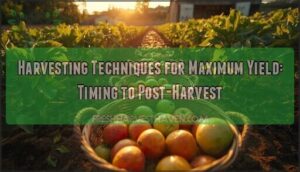This site is supported by our readers. We may earn a commission, at no cost to you, if you purchase through links.

Most vegetables need 6-8 hours of direct sunlight daily, but you’ve got options if your yard’s shadier than ideal.
Full-sun crops like tomatoes, peppers, and squash demand those 6+ hours to produce well.
Partial-sun vegetables such as lettuce, spinach, and broccoli can thrive with 3-6 hours.
Shade-tolerant leafy greens like kale and arugula manage with just 3-4 hours of morning light.
The key is matching each plant to the right spot in your space, ensuring adequate photosynthesis for healthy growth and maximum harvests.
Smart placement and plant selection can turn even challenging light conditions into productive growing areas.
Table Of Contents
- Key Takeaways
- Sunlight Requirements Defined
- Plant Specific Sunlight Needs
- Impact of Sunlight on Plants
- Managing Sunlight for Optimal Growth
- Overcoming Sunlight Limitations
- Frequently Asked Questions (FAQs)
- Can my vegetable garden get too much sun?
- Can you grow vegetables in full shade?
- How much sunlight a day does a vegetable garden need?
- How many hours is considered full sun for vegetables?
- How does soil type affect sunlight absorption?
- Can artificial light supplement insufficient sunlight?
- What tools measure sunlight in garden areas?
- How does altitude impact sunlight intensity?
- Are there vegetables suited for winter sunlight conditions?
- How does seasonal sun angle affect vegetables?
- Conclusion
Key Takeaways
- Match plants to your available light – Full-sun crops like tomatoes need 6-8 hours daily, while leafy greens thrive with just 3-6 hours of direct sunlight
- Use shade-tolerant varieties for challenging spots – You can grow lettuce, spinach, kale, and herbs in areas with only 3-4 hours of morning light
- Assess your garden’s sunlight patterns throughout the day – Track shadows hourly to identify which areas get morning vs. afternoon sun for optimal plant placement
- Create microclimates to maximize limited light – Use reflective surfaces, shade cloth, and strategic positioning to optimize growing conditions even in partially shaded spaces
Sunlight Requirements Defined
Understanding sunlight requirements helps you match the right vegetables to your garden’s conditions, ensuring healthier plants and better harvests.
Different vegetables have specific light needs ranging from full sun to partial shade, with most requiring 4-8 hours of direct sunlight daily for ideal growth.
Full Sun Vegetables
Your garden’s full sun vegetables demand at least 6 hours of direct, unfiltered sunlight daily for peak performance.
These sun-loving crops thrive with 8-10 hours for maximum vegetable garden productivity.
Essential full sun vegetables for your vegetable garden:
- Tomato varieties (require 8+ hours for best yields)
- Pepper types (struggle without adequate sunlight hours vegetables need)
- Bean production (direct sun improves harvests substantially)
- Cucumber care (loves sunshine and warmth combination)
- Squash growth (maximizes with full sunlight requirements)
For ideal growth, consider that sweetcorn loves sunshine and warmth.
Partial Sun Vegetables
Partial sun vegetables need just 3-6 hours of direct sunlight daily, making them perfect for those tricky garden spots.
Leafy greens like lettuce, spinach, and arugula flourish here, along with root crops such as beets and carrots. These adaptable plants actually benefit from afternoon shade during hot weather, preventing bolting and maintaining tender texture.
| Vegetable Type | Examples | Sunlight Hours |
|---|---|---|
| Leafy Greens | Lettuce, Spinach, Kale | 3-6 hours |
| Root Crops | Beets, Carrots, Radishes | 4-6 hours |
| Brassicas | Broccoli, Cabbage | 4-6 hours |
| Herbs | Parsley, Cilantro, Chives | 3-5 hours |
| Bush Beans | Green Beans, Peas | 4-6 hours |
While yield impact may reduce size slightly, these partial sun vegetables often develop superior flavor and extended harvest windows in moderate light conditions.
Consider that more sunlight benefits vegetable growth, even for partial shade varieties.
Shade Tolerant Vegetables
Looking beyond partial sun options, shade tolerant vegetables open up your low-light crops possibilities substantially.
Leafy greens like lettuce, spinach, and kale excel with just 3-4 hours of daily sunlight, making shaded gardens productive spaces.
Root vegetables including beets, carrots, and radishes adapt well to partial shade conditions.
Best varieties for these areas include Asian greens and Swiss chard, which actually prefer cooler, shadier spots over intense sun exposure.
Gardeners can also consider implementing crop rotation to maximize yields.
Minimum Direct Sunlight Needs
Understanding your garden’s survival sunlight requirements helps prevent plant failure and guarantees healthy growth.
Each vegetable type has specific growth thresholds that determine success or struggle in your garden space.
Here are the minimum sunlight requirements for different vegetable categories:
- Full sun vegetables (tomatoes, peppers, squash) need 6+ hours daily for proper development and fruiting minimums
- Leafy greens (lettuce, spinach, kale) survive with 4-6 hours of direct sunlight exposure
- Root crop needs (carrots, beets, radishes) require 4-6 hours minimum for adequate bulb formation
- Herbs (parsley, cilantro, chives) tolerate 2-4 hours but produce better yields with more exposure
Meeting these vegetable sun requirements prevents stunted growth, poor yields, and plant death in your vegetable garden sunlight conditions.
Preferred Direct Sunlight Hours
Most vegetables exceed their minimum sunlight requirements when you provide 8-10 hours of direct sun exposure daily.
This ideal duration maximizes photosynthesis, improving yields and plant health substantially.
| Plant Type | Minimum Hours | Preferred Hours |
|---|---|---|
| Full Sun Vegetables | 6 hours | 8-10 hours |
| Partial Sun Plants | 4-6 hours | 6-8 hours |
| Leafy Greens | 3-4 hours | 4-6 hours |
| Root Vegetables | 4-6 hours | 6-8 hours |
Seasonal variation affects these requirements.
Summer’s intense light may reduce needed exposure time, while spring positioning requires careful light measurement to guarantee adequate sun exposure for your vegetable garden sunlight needs, ensuring maximum yields and maintaining plant health with the right amount of direct sun.
Plant Specific Sunlight Needs
Understanding which plants match your garden’s sunlight conditions prevents costly mistakes and guarantees thriving crops. Each vegetable has specific light requirements that directly impact growth, yield, and overall plant health.
Sun Loving Plants
Thriving in blazing sunlight, sun-loving vegetables demand 8-10 hours of direct sunlight exposure for maximum yields.
Sun-loving crops transform abundant light into exceptional harvests through intensive photosynthesis.
These fruiting vegetables transform abundant light into exceptional harvests through intensive photosynthesis. Heat tolerance and consistent watering needs support their sunlight requirements in your vegetable garden.
Many gardeners also choose heat tolerant plants to guarantee a successful summer harvest.
- Tomatoes basking in morning sun, their leaves glistening with dew
- Peppers standing tall against azure skies, branches heavy with colorful fruits
- Eggplants stretching toward brilliant sunshine, their purple blooms promising abundant harvests
Partial Sun Plants
While sun-loving varieties demand intense light, partial sun plants flourish with just 4-6 hours of direct sunlight daily.
These shade-tolerant vegetables include leafy greens, root crops, and herbs that actually benefit from afternoon protection.
| Vegetable Type | Examples | Hours Needed |
|---|---|---|
| Leafy Greens | Lettuce, spinach, arugula | 4-6 hours |
| Root Vegetables | Carrots, beets, radishes | 4-6 hours |
| Herbs | Parsley, cilantro, chives | 4-6 hours |
| Brassicas | Broccoli, cabbage, kale | 4-6 hours |
Enhance partial sun areas with soil amendments and reflective surfaces to maximize available light for ideal growth.
Shade Tolerant Plants
Many gardeners overlook the potential of shade vegetables and low-light herbs that thrive in dim conditions.
These shade-tolerant vegetables require only 2-4 hours of direct sunlight daily, making previously unusable garden spaces productive. Leafy greens like lettuce and spinach actually prefer partial shade, while root crops adapt well to lower light levels.
- Leafy greens (lettuce, spinach, arugula, kale) excel with minimal sunlight and resist bolting in shade
- Root crops (beets, carrots, radishes) tolerate shade though yields may decrease compared to full sun
- Low-light herbs (mint, parsley, cilantro, chives) produce abundant harvests with just 3-4 hours of sun
- Best varieties include loose-leaf lettuce, Swiss chard, and mesclun mixes for continuous harvesting
Matching Plants to Sunlight Needs
Successful vegetable garden planning starts with sunlight compatibility assessment.
Measure your garden’s sunlight exposure throughout the day, then select crops accordingly.
Plant selection directly impacts yield expectations and growth optimization.
Match sun-loving tomatoes and peppers to areas receiving eight hours of direct light, while positioning leafy greens in spots with four to six hours.
Consider seasonal timing when planning your vegetables layout.
This strategic approach to sunlight requirements guarantees each plant thrives in its preferred conditions, maximizing your harvest potential.
Preventing Plant Stress and Failure
Proper sunlight management prevents most vegetable garden failures before they start.
When you match plant light needs with available sunlight exposure, you eliminate the primary cause of plant stress and poor harvests.
Monitor these warning signs that indicate sunlight-related problems:
- Leggy seedlings stretching desperately toward distant light sources
- Yellowing leaves signaling insufficient energy production through photosynthesis
- Stunted growth with plants remaining small despite adequate watering practices
- Poor fruit development where blossoms drop without forming vegetables
Address nutrient deficiency through improved soil health, maintain consistent pest control, and implement disease prevention strategies alongside proper sunlight management for ideal plant health.
Impact of Sunlight on Plants
Understanding how sunlight affects your vegetables helps you create the perfect growing environment for maximum yields.
The sun’s energy directly controls photosynthesis, growth patterns, flowering cycles, and overall plant health through complex biological processes that determine your garden’s success.
Photosynthesis and Sunlight
Your garden’s photosynthesis process transforms sunlight into plant fuel through precise biochemical steps.
Chlorophyll function begins when leaves capture sunlight, triggering light absorption that drives energy conversion.
This process combines carbon dioxide and water to create glucose production while releasing oxygen as a byproduct.
Sunlight sparks chlorophyll into action, turning light into energy and fueling plants for vibrant growth and tasty harvests.
Sunlight intensity directly affects energy production rates.
When you provide adequate exposure, plants maximize their ability to convert light into plant energy, supporting robust plant growth.
Insufficient sunlight reduces photosynthetic efficiency, leaving vegetables struggling to produce the energy needed for development and fruit production.
Even with limited light, gardeners can still grow certain vegetables by assessing garden light.
Daylength and Plant Growth
While sunlight provides energy, daylength triggers critical growth phases through photoperiodism explained as plants’ response to light duration.
Critical daylength determines when vegetables flower, affecting seasonal growth patterns based on latitude effects.
- Longday plants need 12+ hours to flower properly
- Shortday plants bloom when days shorten below 12 hours
- Dayneutral plants flower regardless of light duration
- Plant photoperiodism causes growth cessation below 10-hour flowering triggers
Photoperiodism and Flowering
Your plants act as natural timekeepers, using plant photoperiodism to determine when to flower.
Nature’s clock ticks through sunlight hours, signaling when vegetables should bloom and produce their harvest bounty.
Longday plants like lettuce need over 12 hours of daylight for flowering, while shortday plants require fewer daylight hours.
Dayneutral plants ignore day length entirely.
When daylight hits each plant’s critical photoperiod, flowering triggers activate plant hormones that initiate seasonal blooms.
Sunlight Intensity and Plant Health
Balancing sunlight intensity creates the foundation for robust plant health in your vegetable garden. While optimal sunlight drives chlorophyll production and growth regulation, excessive intensity can damage plants through heat stress and sunscald.
Light and immunity work together—proper exposure strengthens disease resistance while sunlight and nutrients maximize absorption efficiency.
Monitor your garden’s intensity and yield relationship:
- Provide shade cloth during peak afternoon hours to prevent leaf burn
- Apply organic mulch around plants to regulate soil temperature and moisture
- Watch for white or brown patches on leaves indicating sunscald damage
Understanding your sunlight requirements helps optimize photosynthesis without overwhelming delicate plant tissues.
Angle of Sun and Photosynthesis
Typically, the sun’s angle dramatically affects your garden’s photosynthetic efficiency. Summer’s overhead rays create ideal sunlight exposure, while winter’s low-angle light reduces energy capture.
Seasonal variation forces plant adaptations as they adjust leaf positioning to maximize light spectrum absorption. Understanding sunlight angle helps you orient beds strategically, ensuring crops receive preferred sunlight throughout growing seasons.
Smart gardeners consider these sunlight requirements when planning layouts, positioning tall plants to avoid shading shorter ones during critical photosynthesis periods when sunlight availability peaks.
Managing Sunlight for Optimal Growth
Once you’ve assessed your garden’s sunlight patterns, you’ll need to strategically match plants to their ideal growing conditions.
Managing sunlight effectively requires ongoing monitoring and adjustments to guarantee your vegetables receive the right amount of light throughout their growing season.
Assessing Available Sunlight
Once you’ve understood sunlight’s impact on plant health, you’ll need to map your garden’s actual sunlight exposure.
Start with shadow tests throughout the day, marking where shadows fall hourly. Sunlight meters provide precise measurements of light intensity, while sun calculators help predict sunlight hours across seasonal changes.
Monitor for obstruction monitoring from trees, buildings, or fences that block light. This measuring garden sunlight process reveals your garden sunlight needs and sunlight availability patterns.
For thorough analysis, consider using a complete shadow kit.
Choosing Suitable Plants
Once you understand your garden’s sunlight patterns, selecting vegetables becomes straightforward.
Plant compatibility depends on matching sunlight requirements with available light conditions. Growth habits and space requirements also influence placement decisions.
Consider these key factors when choosing suitable plants:
- Full sun vegetables like tomatoes and peppers need 8+ hours of direct sunlight for maximum production
- Shade-tolerant vegetables including lettuce and spinach thrive with 4-6 hours of filtered light
- Root vegetables such as carrots require moderate sunlight but adapt well to varying conditions
Your vegetable garden’s success relies on understanding each plant’s specific needs for sunlight, soil conditions, and watering requirements.
Experimenting With Crop Placement
Once you’ve chosen suitable plants for your sunlight conditions, experimenting with crop placement maximizes your garden’s potential.
Sunlight mapping reveals how shadows move throughout the day, helping you position plants strategically. Companion planting pairs sun-loving vegetables with shade-tolerant ones, creating efficient microclimate creation.
Seasonal adjustments account for changing light patterns as the sun’s angle shifts. Succession planting staggers harvests while optimizing light conditions.
Your garden layout becomes a living experiment where plant placement evolves with experience. Reflective surfaces can be used to increase light intensity in darker areas.
| Strategy | Implementation |
|---|---|
| Morning Sun Crops | Leafy greens in east-facing areas |
| Afternoon Sun Crops | Tomatoes in west-facing spaces |
| Tall Plant Positioning | North side to avoid shading others |
| Seasonal Rotations | Spring greens to summer squash |
| Vertical Growing | Trellises for maximum light exposure |
Providing Optimal Conditions
Your garden’s success depends on balancing ideal sunlight vegetables with complementary growing conditions.
Sunlight importance vegetables can’t be overstated, but proper water management, temperature control, and soil health create the foundation for thriving crops. Many gardeners find shade cloth solutions helpful in managing light.
- Water Management: Apply consistent moisture without waterlogging, which compromises plant light requirements
- Temperature Control: Install shade cloth during extreme heat to protect sensitive crops
- Air Circulation: Space plants adequately to prevent fungal diseases and improve photosynthesis
- Soil Health: Enrich with organic matter to support nutrient uptake and root development
Effective sunlight optimization requires attention to your vegetable garden location’s microclimate and pest control measures.
Monitoring Plant Health
Once you’ve provided ideal conditions, regular monitoring plant health becomes your garden’s early warning system.
Watch for yellowing leaves, leggy stems, and wilting leaves that signal sunlight imbalances. Growth observation reveals whether plants receive adequate light, while leaf color indicates nutritional stress.
Pest detection often correlates with weakened, poorly-lit plants. Check soil moisture regularly, as stressed plants show increased vulnerability.
| Warning Sign | Likely Cause |
|---|---|
| Yellowing leaves | Insufficient sunlight |
| Leggy stems | Too little light |
| Wilting leaves | Sunlight stress |
| Poor bloom monitoring | Light deficiency |
| Plant diseases | Weakened immunity |
Overcoming Sunlight Limitations
You can still grow a productive vegetable garden even when sunlight is limited in your space.
Smart plant selection and strategic techniques will help you maximize your harvest despite challenging light conditions, with smart plant selection being crucial.
Growing in Partial Shade
Successfully creating shade vegetables requires strategic planning despite limited sunlight conditions.
Many shadetolerant vegetables actually prefer partial shade environments over intense sun exposure.
Here’s your action plan:
- Select appropriate varieties: Choose leafy greens, root crops, and tolerant herbs that thrive in lowlight environments
- Enhance growing conditions: Add soil amendments like compost to boost nutrient availability in shaded areas
- Maximize available light: Position reflective surfaces near plants to redirect sunlight into darker garden spots
- Monitor shade tolerance: Watch for signs that plants need relocation to areas with better light exposure
Using Herbs and Leafy Greens
When sunlight for vegetables runs short, herbs and leafy greens become your garden’s MVPs.
Herb sunlight needs are modest—parsley, cilantro, and chives flourish with just 4-6 hours daily. Leafy green varieties like spinach, lettuce, and arugula tolerate shade-tolerant vegetables conditions beautifully.
These optimal sunlight vegetables offer incredible culinary herb uses from fresh salads to flavor-packed sauces. Companion planting herbs alongside struggling plants can improve overall garden health while maximizing limited light exposure effectively.
Selecting Sun Tolerant Plants
While herbs and leafy greens thrive in limited light, expanding your shade-tolerant vegetable garden requires strategic plant selection based on sunlight requirements.
Choose wisely to maximize your growing success:
- Low-Sun Options: Arugula, spinach, and kale adapt beautifully to partial shade conditions
- Compact Sun Lovers: Bush beans and determinate tomatoes work in smaller, sunny spots
- Heat-Tolerant Veggies: Swiss chard and collards handle both sun and temperature fluctuations
- Drought-Resistant Choices: Mediterranean herbs like oregano thrive with minimal water and light exposure
Smart plant selection prevents stress and failure while maintaining productivity in challenging conditions.
Managing Excess Sun and Heat Stress
When temperatures soar above 90°F, your vegetables show distress through wilting and sunburn.
Install shade cloths with 30-50% density during peak afternoon heat to prevent flower drop and leaf scorch.
Watering strategies include deep morning irrigation and avoiding fertilization during heat stress.
Apply reflective mulch to reduce soil temperatures by 10°F.
Select heat-resistant varieties and practice bolting prevention through proper spacing.
Shade structures and soil cooling techniques protect your harvest when Mother Nature cranks up the thermostat.
Creating Microclimates for Plant Growth
Your garden becomes a collection of unique environments when you master microclimate creation. Reflective surfaces bounce extra light to shaded areas, while wind protection shields tender plants from harsh conditions.
Strategic placement helps you control soil temperature and humidity control around different crops. Smart water management groups thirsty plants together for efficiency.
Key microclimate techniques include:
- Using sun mapping garden data to position heat-loving crops near warm walls
- Creating garden orientation that maximizes morning sun exposure
- Installing shade cloth during peak summer heat
- Positioning tall plants to shelter shorter ones
- Adjusting garden sun exposure with strategic barriers
These methods let you fine-tune sunlight direction garden flow, matching each plant’s sunlight requirements perfectly. Many gardeners also find success using specialized garden products to enhance their sun mapping strategies.
Frequently Asked Questions (FAQs)
Can my vegetable garden get too much sun?
Too much of a good thing can be harmful – while vegetables need sunlight, excessive exposure above 10-12 hours daily can stress plants.
Causing leaf scorch, wilting, and reduced yields, especially during hot summer months.
Can you grow vegetables in full shade?
Growing vegetables in full shade (less than 2 hours of direct sunlight) isn’t realistic for most crops.
You’ll need at least partial shade with filtered light for leafy greens like lettuce and spinach to survive.
How much sunlight a day does a vegetable garden need?
Absolutely nothing beats proper sunlight for your vegetable garden’s success! Most vegetables need 6-8 hours of direct sunlight daily, though leafy greens can thrive with just 4-6 hours of sun.
How many hours is considered full sun for vegetables?
Full sun for vegetables means you’ll need 6 or more hours of direct sunlight daily.
This continuous or split exposure provides the energy your tomatoes, peppers, and other sun-loving crops need to thrive.
How does soil type affect sunlight absorption?
Soil type doesn’t directly affect sunlight absorption, but it influences how well your plants use that light. Well-draining soils help roots access nutrients, maximizing photosynthesis efficiency from available sunlight.
Can artificial light supplement insufficient sunlight?
Like turning on a lighthouse beacon in fog, artificial light can rescue your vegetable garden when natural sunlight falls short.
You’ll need LED grow lights providing 14-16 hours daily to match photosynthesis requirements effectively.
What tools measure sunlight in garden areas?
You’ll need sunlight meters, lux meters, or smartphone apps to measure light intensity and duration.
Use physical markers or sun calculator apps to track sunlight patterns throughout the day across different garden areas, which can help identify complete concepts of sunlight exposure.
How does altitude impact sunlight intensity?
As Shakespeare might say, "the higher we soar, the smaller we appear to those who can’t fly.
At higher elevations, you’ll experience 10-12% more UV radiation per thousand meters because thinner atmosphere filters less sunlight.
Are there vegetables suited for winter sunlight conditions?
Winter brings shorter days and weaker sunlight, but you can still grow cold-hardy vegetables. Kale, spinach, Brussels sprouts, and winter lettuce thrive in lower light conditions and frost.
How does seasonal sun angle affect vegetables?
Seasonal sun shifts substantially impact your vegetable garden’s productivity, requiring strategic plant placement adjustments as winter’s lower angle reduces light intensity and duration for ideal growth.
Conclusion
Like a gardener matching each seed to its perfect patch of earth, understanding sunlight requirements for vegetable garden success transforms your growing space into a thriving ecosystem.
You’ve learned to place sun-loving tomatoes in bright spots while tucking shade-tolerant lettuce under partial cover.
By evaluating your yard’s light patterns and selecting appropriate crops, you’ll maximize harvests regardless of conditions.
Remember, even challenging spaces can become productive when you match plants to their ideal light requirements.



